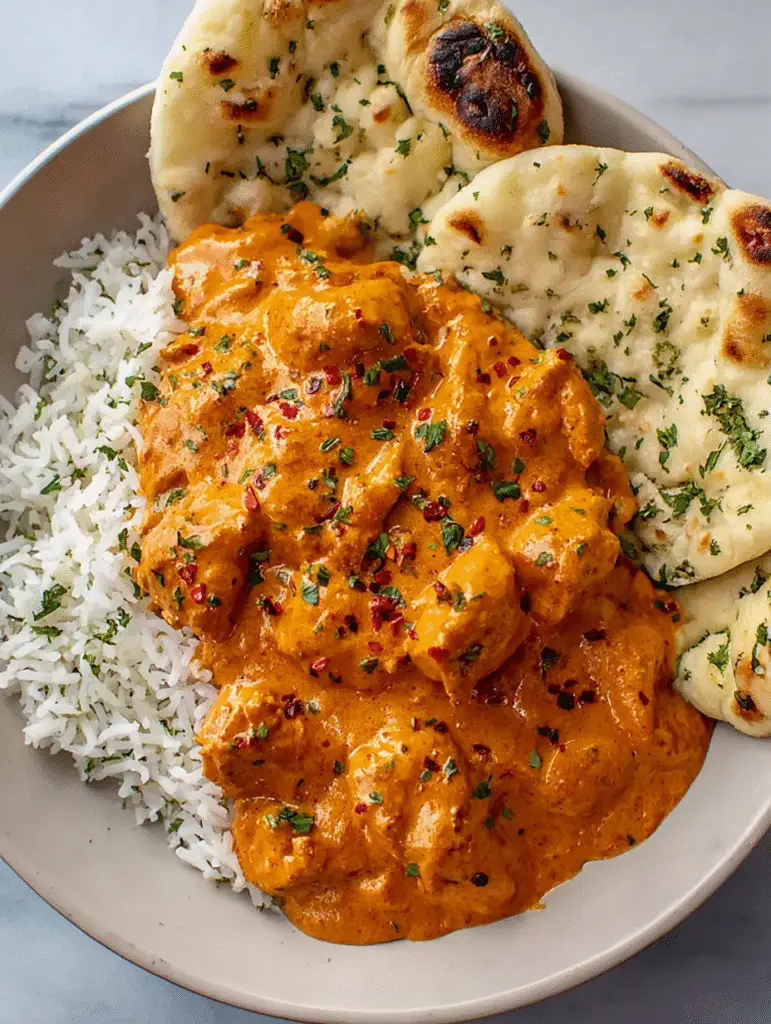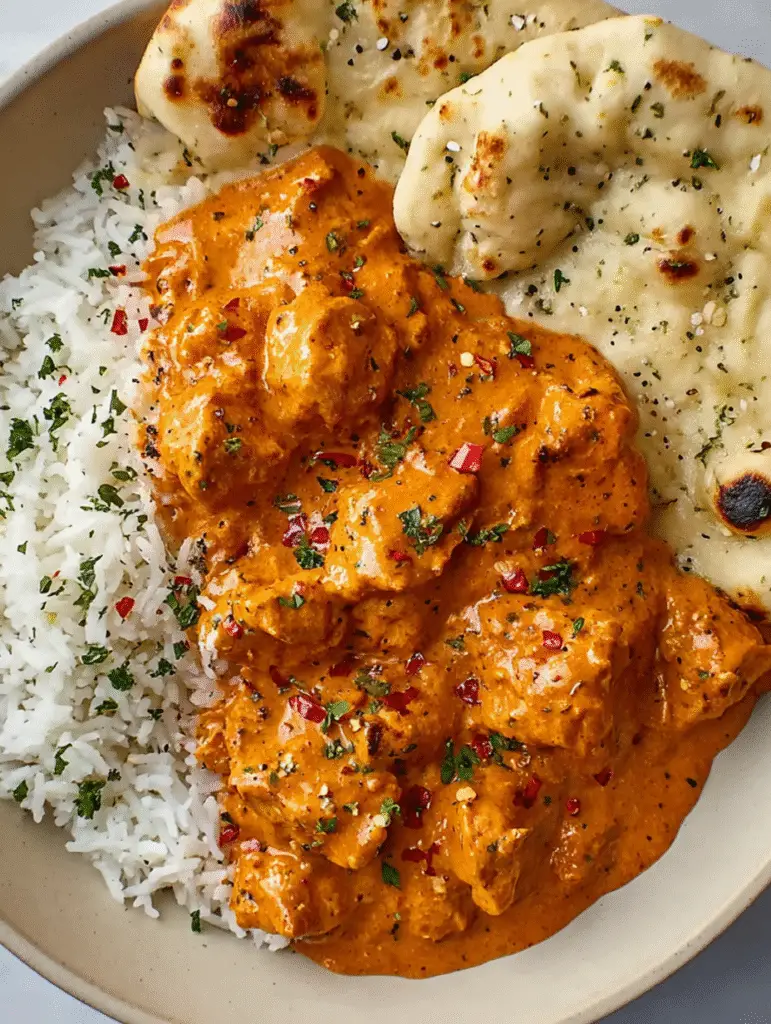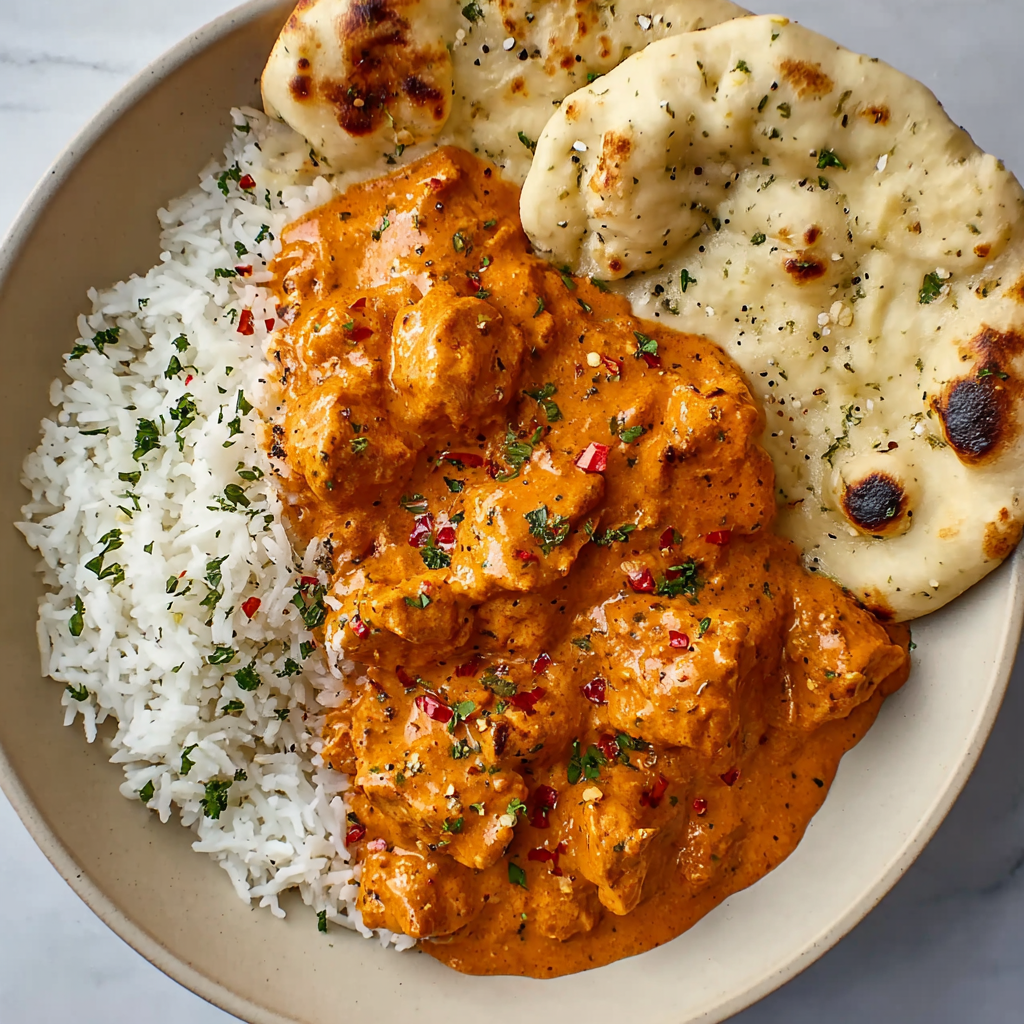Introduction
There’s something magical about the aroma of butter chicken simmering on the stove—it instantly transforms your kitchen into a warm, inviting space that feels like home. This beloved Indian dish has captured hearts worldwide, and for good reason. What started as a happy accident in a Delhi restaurant has become one of the most cherished comfort foods across cultures.
Growing up, I always thought butter chicken was too complex to attempt at home. However, after years of experimenting and simplifying traditional techniques, I’ve discovered that this creamy, aromatic masterpiece is surprisingly approachable. Moreover, the homemade version allows you to control every ingredient, ensuring a healthier and more personalized result than most restaurant versions.
Prep Time: 5 minutes
Cook Time: 25 minutes
Marinate Time: 15 minutes
Total Time: 45 minutes
Servings: 4 people
Course: Main Course
Cuisine: Indian-American Fusion
Why You’ll Love This Butter Chicken Recipe
Restaurant-Quality Results at Home
This recipe delivers the same velvety texture and complex flavors you’d expect from your favorite Indian restaurant. Furthermore, you can adjust spice levels to suit your family’s preferences without compromising authenticity.
Simple Ingredients, Big Impact
Unlike many traditional recipes that require hard-to-find spices, this version uses pantry staples that most home cooks already have. Additionally, the ingredient list is streamlined without sacrificing the dish’s signature richness.
Quick Weeknight-Friendly
With only 45 minutes from start to finish, this butter chicken fits perfectly into busy weeknight schedules. Meanwhile, the 15-minute marinating time allows you to prep other components of your meal.
Crowd-Pleasing Appeal
This recipe consistently wins over both spice enthusiasts and those who prefer milder flavors. Consequently, it’s become my go-to dish for entertaining guests with varying taste preferences.
Essential Ingredients
For the Chicken & Marinade
- 1½ pounds skinless boneless chicken thighs, cut into bite-sized chunks
- 1 teaspoon salt
- 1 teaspoon garlic powder
- 1 teaspoon sweet paprika
- ½ teaspoon curry powder
- 1 tablespoon Greek yogurt
Building the Perfect Sauce
- 3 tablespoons vegetable oil
- 3 tablespoons butter, divided
- 6 garlic cloves, minced
- 1 medium onion, diced
- 1 (15-ounce) can tomato sauce
- 1 teaspoon sugar
- 1 teaspoon salt (adjust to taste)
- ½ teaspoon black pepper
- 2 cups heavy cream
- ½ teaspoon cayenne pepper (optional for heat)
- 1 teaspoon garam masala
- ½ teaspoon curry powder
- ¼ cup freshly chopped parsley (optional, for garnish)
Perfect Serving Companions
- Naan bread
- Steamed basmati rice
Required Equipment
- Large skillet or heavy-bottomed pan
- Medium mixing bowl
- Sharp knife and cutting board
- Wooden spoon for stirring
Step-by-Step Instructions
Preparing the Chicken Foundation
Begin by creating the marinade that will infuse your chicken with incredible flavor. In a medium bowl, combine the chicken pieces with salt, garlic powder, sweet paprika, curry powder, and Greek yogurt. Mix thoroughly, ensuring every piece is well-coated with the aromatic blend.
Allow the chicken to marinate for at least 15 minutes. During this time, you can dice your onion and mince the garlic, making the cooking process seamless once you start.
Achieving the Perfect Sear
Heat three tablespoons of oil in a large skillet over medium-high heat. Once the oil shimmers, add the marinated chicken pieces in a single layer. Cook for 8-10 minutes, stirring occasionally, until the chicken develops a beautiful golden-brown exterior and reaches an internal temperature of 165°F.
Remove the chicken from the skillet and set it aside, but don’t discard the flavorful oil—it’s packed with spices that will enhance your sauce.
Creating the Aromatic Base
Reduce heat to medium and add one tablespoon of butter to the same skillet. The butter will help deglaze the pan, lifting those precious browned bits that add depth to your sauce. If needed, add a splash of water to help with this process.
Next, add the minced garlic and diced onion along with a pinch of salt. Sauté until the onion becomes translucent and the mixture becomes fragrant, typically 3-4 minutes.
Building Layers of Flavor
Stir in the tomato sauce and sugar, creating the foundation of your butter chicken sauce. The sugar balances the acidity of the tomatoes while adding subtle sweetness that’s characteristic of this dish. Let this mixture simmer for 2-3 minutes, allowing the flavors to concentrate.
Return the golden chicken to the skillet and mix well. Pour in the heavy cream gradually, stirring constantly to prevent curdling. Watch as the sauce transforms into a beautiful orange hue that’s Instagram-worthy.
Final Seasoning and Simmering
Add the cayenne pepper (if using heat), garam masala, curry powder, and black pepper to the creamy mixture. Reduce heat to low and let the sauce simmer gently for 10 minutes. This slow cooking process allows all the spices to meld together, creating the complex flavor profile that makes butter chicken so irresistible.
Taste and adjust seasoning as needed—some prefer more salt, while others might want an extra pinch of garam masala.
The Silky Finish
Remove the skillet from heat and stir in the remaining two tablespoons of cold butter. This final addition creates the signature silky texture that gives butter chicken its luxurious mouthfeel. Sprinkle with freshly chopped parsley for a pop of color and fresh flavor contrast.

Serving Suggestions
Traditional Pairings
Serve your homemade butter chicken hot alongside warm naan bread and fluffy basmati rice. The naan is perfect for scooping up the creamy sauce, while the rice provides a neutral base that absorbs all those incredible flavors.
Creative Serving Ideas
Consider serving over cauliflower rice for a low-carb alternative, or try it with quinoa for added protein. Additionally, roasted vegetables like bell peppers or zucchini make excellent sides that complement the rich sauce.
Presentation Tips
Garnish with a dollop of plain yogurt, a sprinkle of fresh cilantro, and a light dusting of garam masala for restaurant-style presentation. Furthermore, serve with lemon wedges on the side for guests who enjoy a bright acidic contrast.
Recipe Variations
Spice Level Adjustments
For those who prefer milder flavors, omit the cayenne pepper and reduce the garam masala by half. Conversely, heat lovers can add an extra ½ teaspoon of cayenne or include a diced jalapeño with the onions.
Protein Alternatives
While chicken thighs provide the most tender results, boneless chicken breasts work well too—just reduce cooking time slightly. Moreover, this sauce pairs beautifully with paneer, shrimp, or even roasted vegetables for vegetarian options.
Dairy-Free Version
Substitute the heavy cream with full-fat coconut milk and use vegan butter alternatives. The result is equally creamy with a subtle tropical note that complements the spices beautifully.
Healthier Modifications
Replace heavy cream with a mixture of Greek yogurt and chicken broth for a lighter version. Additionally, using Greek yogurt adds extra protein while maintaining the creamy texture.
Make-Ahead Tips
Marinating in Advance
The chicken can be marinated up to 24 hours ahead, which actually improves the flavor penetration. Store covered in the refrigerator and bring to room temperature before cooking.
Preparing Components
Dice onions and mince garlic up to two days in advance. Store separately in airtight containers in the refrigerator to streamline your cooking process.
Complete Make-Ahead Strategy
The entire dish can be prepared up to three days ahead and refrigerated. The flavors actually improve over time, making this an excellent option for meal prep or entertaining.
When reheating, add a splash of cream or broth to restore the sauce’s consistency, as it tends to thicken when chilled.
Important Notes
Ingredient Quality Matters
Use good-quality garam masala for the best flavor—freshly ground spices make a noticeable difference. Additionally, full-fat heavy cream creates the richest, most luxurious sauce texture.
Temperature Control
Maintain medium heat when adding cream to prevent curdling. If your sauce does curdle, remove from heat immediately and whisk in a tablespoon of cold cream.
Storage Guidelines
Leftover butter chicken keeps in the refrigerator for up to four days and freezes beautifully for up to three months. However, the sauce may separate slightly when frozen—simply stir while reheating to restore smoothness.
Scaling the Recipe
This recipe doubles or halves easily, making it perfect for both intimate dinners and large gatherings. When doubling, you may need to cook the chicken in batches to avoid overcrowding the pan.

Frequently Asked Questions
Can I use chicken breasts instead of thighs?
Absolutely! While thighs remain more tender and flavorful, chicken breasts work well too. Simply reduce the cooking time by 2-3 minutes and ensure they don’t overcook, as breasts can become dry more quickly than thighs.
How can I make this dish less spicy for kids?
Omit the cayenne pepper entirely and reduce the curry powder to ¼ teaspoon. You can also add an extra tablespoon of cream to mellow any remaining heat. Most children love the mild, creamy version.
What if I don’t have garam masala?
You can create a substitute by mixing equal parts ground cinnamon, cardamom, and cloves with a pinch of nutmeg. While not identical, this blend provides similar warm, aromatic notes.
Can this recipe be made in a slow cooker?
Yes! Brown the chicken first, then transfer everything except the cream and final butter to your slow cooker. Cook on low for 4-6 hours, then stir in cream and butter during the last 30 minutes.
Why is my sauce not as orange as restaurant versions?
Restaurant butter chicken often contains artificial coloring or extra tomato paste. For a deeper color, add 2-3 tablespoons of tomato paste with the tomato sauce, or include a pinch of turmeric for golden hues.
How do I prevent the cream from curdling?
Always add cream gradually while stirring, and keep the heat at medium or below. If curdling occurs, immediately remove from heat and whisk in cold cream or a splash of cold water to stabilize the sauce.

